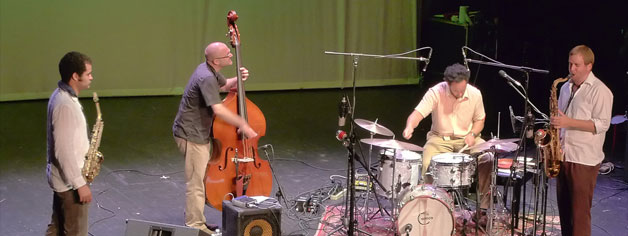A Primer on Saxophone Improvisation Without Chords
 This is a guest post from Bill Harrison, the man behind the innovative jazz play-along series of MP3s and sheet music, Play Jazz Now.
This is a guest post from Bill Harrison, the man behind the innovative jazz play-along series of MP3s and sheet music, Play Jazz Now.
Lately I’ve been thinking about some of the great jazz music that has been made without a chording instrument in the ensemble. Traditionally, the jazz rhythm section has included at least one instrument capable of easily executing chords – piano, guitar or vibraphone. Many bands feature more than one harmony provider (Modern Jazz Quartet, Oscar Peterson’s Trio with Barney Kessel, Gary Burton’s groups with guitar, Pat Metheny and Lyle Mays, etc etc). A lot of beautiful music has been made this way and harmony is, of course, one of the essential elements of musical language. But there have also been many jazz musicians who have chosen to perform without piano, guitar or vibes present.
This category has to include so-called avant garde music, some of which is composed specifically excluding functional harmony. The music of Ornette Coleman, The Art Ensemble of Chicago, Anthony Braxton and Albert Ayler are examples of this kind of jazz.
Sax without Borders
There are also plenty of great saxophonists who play traditional song forms without a chording instrument, so that the harmonies are implied rather than stated. Sonny Rollins, Gerry Mulligan, Chet Baker, Lee Konitz, and Eric Dolphy are some of the jazz masters who have played traditional tunes this way. The players (and listeners) are challenged to hear the “changes” via the interplay between the soloist’s melody and the bass line. In other words, it is the counterpoint between the two (or more) instrumental voices that creates the impression of harmony.
The Classical Perspective
A certain kind of textural transparency and harmonic freedom is created when there isn’t someone providing chordal accompaniment throughout a jazz performance. European “classical” music provides a good aural analogy: think of how the “sound world” of J.S. Bach’s keyboard music compares to that of, say, Claude Debussy. Despite the functional harmonic simplicity of Bach’s music, there is a complexity in the texture created by the disparate lines of melody that can be both challenging and fascinating to follow. Debussy’s harmonic language is much less directly functional, but the overally impression (sorry about the pun) is one of density of harmony and an absence of linear clarity. Another way to state this might be that Debussy’s music depends a lot more on vertical (chordal) texture than does Bach’s.
It Ain’t Easy
Playing jazz without piano, guitar or vibes requires a set of skills that aren’t always put to the test when those chordal instruments are present. For bassists, simplicity and clarity generally have to take precedence over the other aspects of creating satisfying bass parts. I recall reading an interview with the great bassist Ron Carter, in which he said (and I’m paraphrasing here) that one should be able to tell what tune is being played by hearing the bassist walk through the changes without any other accompaniment. Now that’s clarity in a bass part!
For saxophonists, the challenges are many: The soloist no longer has the cushion of chordal textures to provide context for his lines. Neither will there be anyone there filling in the aural space when the player takes a breath. No one will be suggesting alternate harmonies, rhythms or melodies in the way that most jazz players are probably used to. The bassist can only do so much as a single line instrument to help keep the form of the tune straight, both harmonically and rhythmically. So sax players have to take on more responsibility for these important formal considerations if the music is to not only cohere but fly.
Here’s a list of some great mainstream (non avant garde) jazz recordings of saxophonists playing without a chordal instrument:
- Sonny Rollins: Night at the Village Vanguard, Way Out West, East Broadway Run Down
- Lee Konitz: Duets, Konitz Meets Mulligan
- Gerry Mulligan: The Original Quartet with Chet Baker
- Eric Dolphy: Out There
- Joe Lovano: Trio Fascination






January 23, 2013 @ 4:28 am
i want 2 know how 2 play
January 23, 2013 @ 2:27 pm
i dnt knw if u cn giv me sum lesson writing it 4 me sum scale i cn b ascending and descending